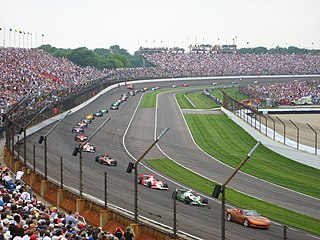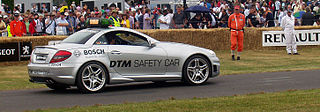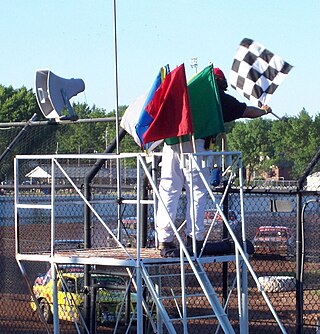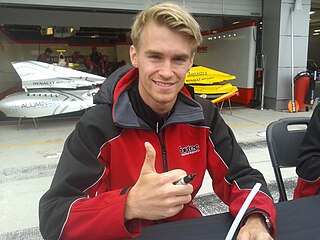
Jacques Bernard Edmon Martin Henri "Jacky" Ickx is a Belgian former racing driver who won the 24 Hours of Le Mans six times and achieved eight wins and 25 podium finishes in Formula One. He greatly contributed to several World Championships for Makes and World Sports Car championships: Ford (1968), Ferrari (1972), Porsche (1976–1977) and (1982–1985) by his 37 major World Sports Car wins. He also won the Can-Am Championship in 1979 and the 1983 Paris–Dakar Rally.

Eliseo Salazar Valenzuela is a Chilean former racing driver. As of 2024, he is the only Chilean to have participated in a Formula One World Championship. He made his Formula One debut on 15 March 1981, and ultimately contested 37 races scoring a total of three championship points. After Formula One, Salazar has participated in numerous motorsport disciplines, including the Chilean national rally championship, Formula 3000, IndyCar, and the World Sportscar Championship.

The Indianapolis 500 auto race has used a pace car every year since 1911. The pace car is utilized for two primary purposes. At the start of the race, the pace car leads the assembled starting grid around the track for a predetermined number of unscored warm-up laps. Then if the officials deem appropriate, it releases the field at a purposeful speed to start the race. In addition, during yellow flag caution periods, the pace car enters the track and picks up the leader, bunching the field up at a reduced speed.

In motorsport, a safety car, or a pace car, is an automobile which limits the speed of competing cars or motorcycles on a racetrack in the case of a caution period such as an obstruction on the track or bad weather. The aim of the safety car is to enable the clearance of any obstruction under safer conditions, especially for marshals and/or await more favourable track conditions weather-wise. By following the safety car, the competitors' tyres remain as close as possible to operating temperature while their engines do not overheat. A safety car is also preferred over stopping the race and restarting as the latter takes longer.

The 24 Hours of Le Mans is an endurance-focused sports car race held annually near the town of Le Mans, France. It is widely considered to be one of the world's most prestigious races, and is one of the races—along with the Monaco Grand Prix and Indianapolis 500—that form the Triple Crown of Motorsport, and is also one of the races alongside the 24 Hours of Daytona and 12 Hours of Sebring that make up the informal Triple Crown of endurance racing. Run since 1923, it is the oldest active endurance racing event in the world.

Tom Kristensen is a Danish former racing driver. He holds the record for the most wins at the 24 Hours of Le Mans with nine, six of which were consecutive. In 1997, he won the race with the Joest Racing team, driving a Tom Walkinshaw Racing-designed and Porsche-powered WSC95, after being a late inclusion in the team following Davy Jones' accident that eventually ruled him out of the race. All of his subsequent wins came driving an Audi prototype, except in 2003, when he drove a Bentley prototype. In both 1999 and 2007 Kristensen's team crashed out of comfortable leads in the closing hours of the race. He is considered by many to be the greatest driver ever to have raced in the 24 Hours of Le Mans.

Donald Scott Goodyear is a Canadian retired racing driver. He competed in CART Championship cars and the Indy Racing League. Along with Michael Andretti, Goodyear is the only driver to have won the Michigan 500 more than once, in 1992 and 1994. Goodyear also twice finished second in the Indianapolis 500, both times under contentious circumstances.

Scott Sharp is an American professional racing driver in the United SportsCar Championship. He is the son of six-time SCCA champion Bob Sharp. Sharp is best known for his years as a competitor in the Indy Racing League.

Racing flags are traditionally used in auto racing and similar motorsports to indicate track conditions and to communicate important messages to drivers. Typically, the starter, sometimes the grand marshal of a race, waves the flags atop a flag stand near the start/finish line. Track marshals are also stationed at observation posts along the race track in order to communicate both local and course-wide conditions to drivers. Alternatively, some race tracks employ lights to supplement the primary flag at the start/finish line.

Townsend Lorenz Bell is an American professional motor racing driver competing in the IMSA WeatherTech SportsCar Championship, and also as a motorsports commentator for NBC Sports’ IndyCar Series coverage.

A rolling start is one of two modes of initiating or restarting an auto race; the other mode is the standing start. In a rolling start, the cars are ordered on the track and are led on a certain number of laps at a predetermined safe speed by the safety car.

Raphael Matos is a Brazilian professional racing driver. He was the 2008 Firestone Indy Lights Series champion and the 2007 Champ Car Atlantic Series champion. He lives in Miami.

Maximilian Alexander Chilton is a British racing driver who last competed for Carlin Motorsport in the IndyCar Series, before announcing his retirement from IndyCar in February 2022. Prior to IndyCar, he competed in Formula One, driving for Marussia F1 in 2013 and 2014. In 2012, he raced in the GP2 series for Marussia-backed Carlin Motorsport.
The following is a glossary of terminology used in motorsport, along with explanations of their meanings.

Tristan Vautier is a French professional racing driver who is currently competing in the 2023 FIA World Endurance Championship for the Vanwall Racing Team.

Oliver "Oli" James Webb is a British auto racing driver. He is a 2004 Karting Champion, 2007 Formula BMW Scholarship winner, 2010 Formula 3 competitor, 2014 European Le Mans series Champion, 2015 Dubai 24 Hour Champion, and W Motors Ambassador.

DragonSpeed Racing is an American racing team that competes in the European Le Mans Series, FIA World Endurance Championship and the 24 Hours of Le Mans. In 2019, the team entered the NTT IndyCar Series with a five race schedule, including the 103rd Indianapolis 500, with car #81 driven by Ben Hanley. For the Year 2021 24 Hours of Le Mans race, Team DragonSpeed USA won First Place Trophy in the LMP2 Pro/Am Category, in an Oreca 07, car #21, driven by Henrik Hedman, Ben Hanley and Juan Pablo Montoya.

Sean Rayhall is a racing driver. He competed in the LMP3 class of the European Le Mans Series, winning the championship in 2017. He has also previously raced in the GT Daytona class of the WeatherTech SportsCar Championship, in addition to stock cars and formula cars, where in the latter, he earned a test opportunity with Chip Ganassi Racing.

Kyffin Simpson is a Caymanian racing driver competing in the IndyCar Series with Chip Ganassi Racing. He won the 2023 European Le Mans Series championship with Algarve Pro Racing.
Nolan Siegel is an American racing driver. He currently competes in the Indy NXT with HMD Motorsports and competes part-time in the IndyCar Series with Dale Coyne Racing. Siegel previously competed in the U.S. F2000 National Championship with DEForce Racing.






















